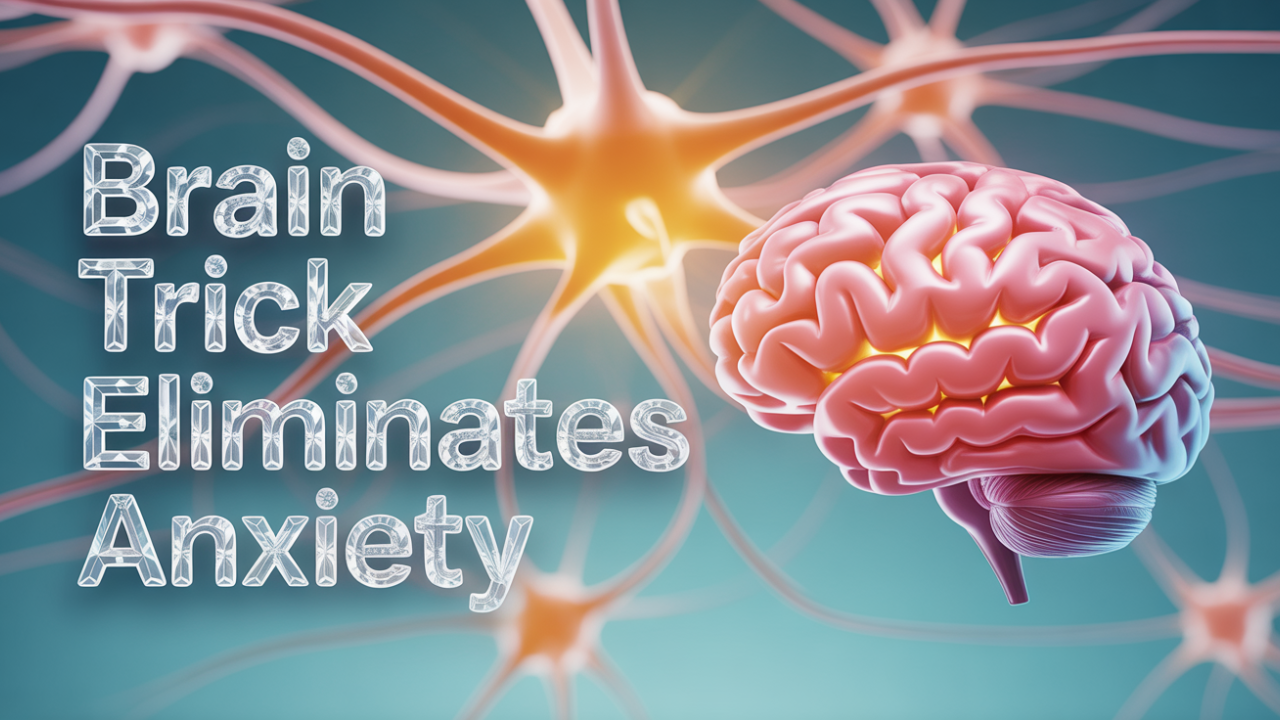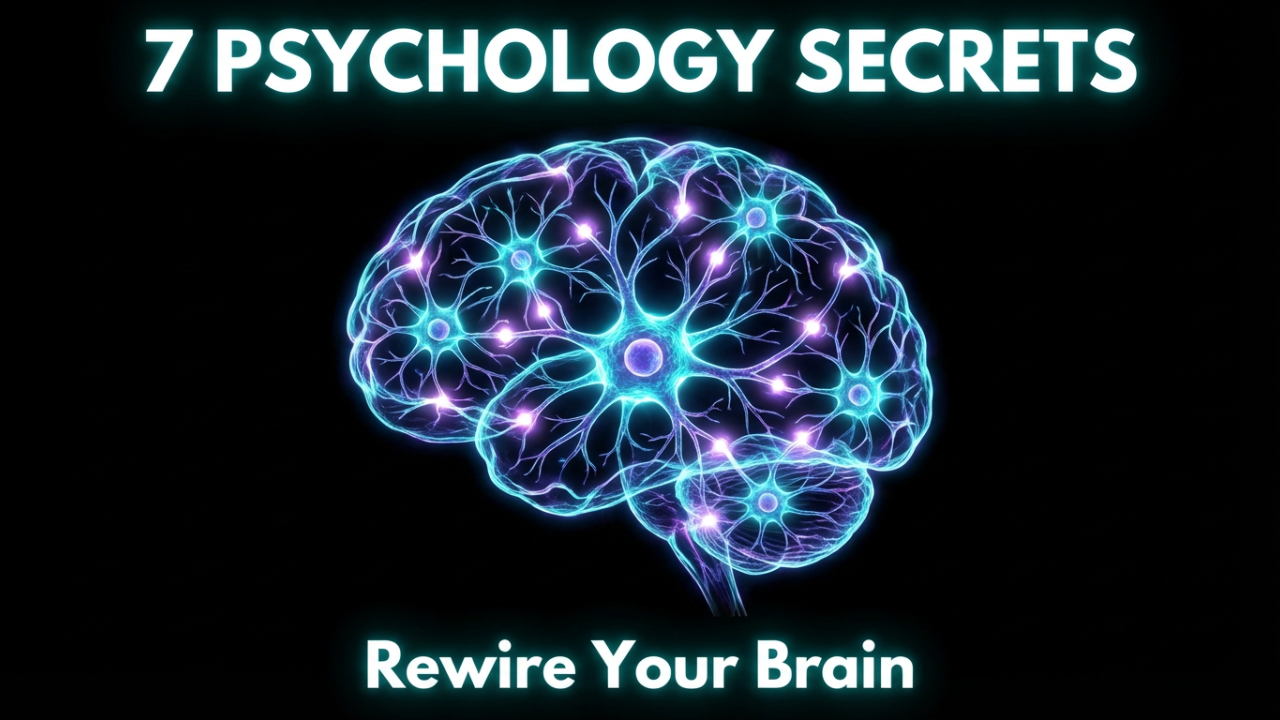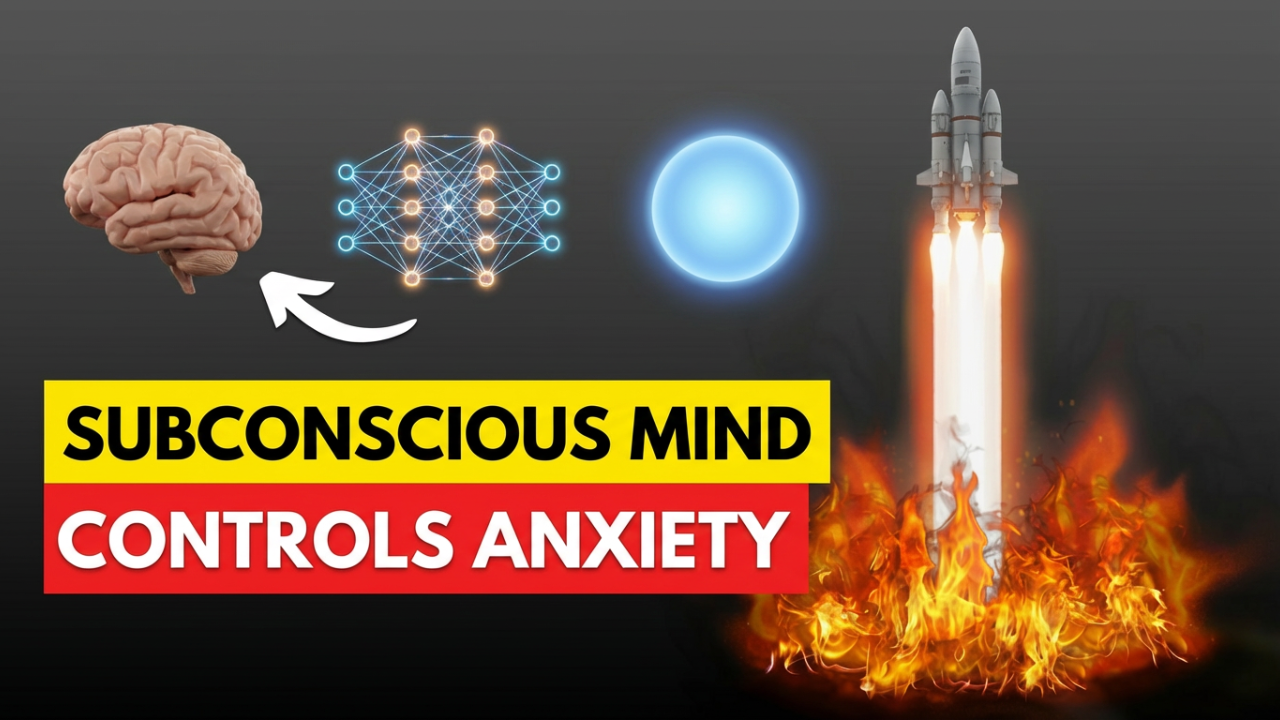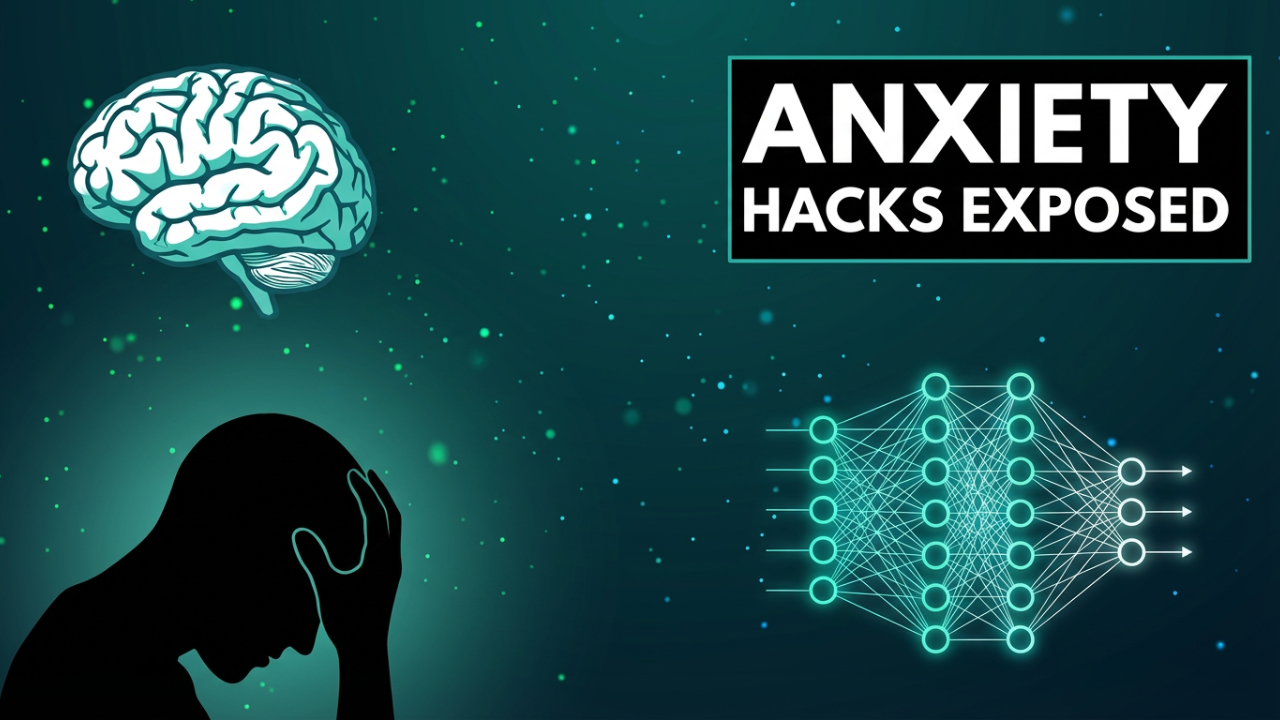It starts in your chest, doesn’t it? A tightness. A strange flutter that isn’t excitement. Your heart starts pounding, a frantic drumbeat telling you something is wrong. Your thoughts, once clear, start to spiral, picking up speed, twisting into worst-case scenarios. That cold, familiar wave of dread washes over you, and the world seems to shrink, its colors dimming until all that’s left is the roaring panic in your head.
You’ve been told to ‘just calm down.’ You’ve been told to ‘think positive,’ to ‘just breathe.’ But it never really works, does it? If anything, it makes you feel worse. It adds a layer of failure on top of the fear—the feeling that not only is your brain broken, but you’re not trying hard enough to fix it.
But what if the secret to stopping anxiety wasn’t about fighting it? What if it wasn’t about willpower or positive thinking?
What if the entire way we look at anxiety is wrong?
What if it’s not some deep character flaw, but a simple… predictive mistake your brain is making? A correctable error in the system.
Fascinating research is now emerging from neuroscience labs at places like Stanford, revealing a powerful technique that’s said to stop anxiety in its tracks. It’s so simple and primal that it can bring immediate relief. But there’s an even bigger claim: that with practice, this one trick can fundamentally rewire the anxious brain.
In this article , we’re putting that controversial ‘forever’ claim to the test. We’ll peel back the myths surrounding anxiety, look at the wiring of your brain to understand *why* you feel this way, and then reveal a simple, science-backed technique you can use to take back control. We’re going to uncover the scientific truth about rewiring your brain for a calmer life.
The cycle can feel unbeatable. The dread of a future event. The panic in a social situation. The 3 AM wake-up call where your mind instantly floods with everything that could possibly go wrong. For millions, this isn’t a rare event; it’s the background noise of daily life.
You’ve tried to battle it. You’ve tried to reason with it. But anxiety doesn’t listen to reason. It operates on a deeper, more primal level. It can feel like a hijacker that has taken over the controls.
But what if you had a hidden switch? A biological override button you never knew existed, one that could interrupt that hijacker and give you back the controls in seconds. Stay with me, because that switch is real. And by the end of this article , you’ll know exactly how to use it.
This book is scientific documentary of the Kingdom of God.
**(Section 1: The Problem Deep Dive – Why Anxiety Feels Unbeatable)**
To find the solution, we have to really understand the problem. And the problem is, anxiety is a tyrant. It’s a master of ‘what ifs.’ It makes you rehearse tragedy and feel the sting of rejection before you’ve even walked into the room. It’s not just a feeling; it’s a full-body experience. The tense shoulders, the churning stomach, the shallow breath—it’s a state of emergency, even when you’re perfectly safe.
The world is full of well-meaning advice, but most of it is tragically flawed. Let’s break down why the old way so often fails.
First, the classic: “Just think positive.” This is like telling someone with a broken leg to just ‘walk it off.’ When anxiety strikes, it’s not a failure of attitude; it’s a biological event. A specific part of your brain, the amygdala, has taken over. Think of the amygdala as your brain’s hyper-sensitive smoke alarm. Its job is to detect threats—real or perceived—and flood your system with stress hormones to prepare you for fight or flight.
When that alarm is blaring, your prefrontal cortex—the logical, ‘thinking positive’ part of your brain—is basically taken offline. The amygdala hijacks the system. So, telling yourself to “think positive” is like politely asking a fire to put itself out. The wiring for logical thought is being drowned out by the siren of raw, primal fear.
Then there’s the advice to “Avoid your triggers.” Sure, this offers short-term relief. But it’s a long-term trap. Every time you avoid something out of fear, you send a signal back to your brain: “You were right to be scared. That thing really *is* dangerous.”
This creates a feedback loop. Avoidance brings a momentary wave of calm, and your brain learns to seek that reward. But the fear doesn’t go away; it grows. The neural pathway for that fear gets stronger. Your world shrinks. First, it’s big crowds. Then it’s grocery stores. Then it’s leaving the house at all. Avoidance doesn’t solve anxiety; it feeds it.
This is the tyranny of the anxious brain: a vicious, self-perpetuating cycle. Chronic stress actually makes the amygdala more sensitive and weakens the connections to the prefrontal cortex, the part that’s supposed to say, “Hey, hang on, this is a false alarm.”
This is neuroplasticity working against you. Neuroplasticity is the brain’s ability to rewire itself based on experience. When you repeatedly experience anxiety, you are, in essence, practicing being anxious. You’re carving a deep, wide neural pathway for fear, making it the brain’s default road.
Imagine your brain is a forest. Your most common thoughts are well-trodden paths. For someone with chronic anxiety, the path of fear is a superhighway. The path of calm is an overgrown trail. When a trigger appears, which path do you think your brain takes automatically? The superhighway, every time. This is why anxiety feels so automatic. You’ve inadvertently trained your brain to be an expert at being anxious. It’s not your fault; it’s just how the brain works.
Breaking this cycle requires more than willpower. It requires interrupting the cycle on a neurological level and starting to carve a new path in that forest.
**(Section 2: The Myth & The Big Reveal – A New Understanding)**
For decades, we’ve been told that anxiety is just a product of the ‘fight or flight’ response. A saber-toothed tiger jumps out, your brain panics, you run. Today, the tiger is an angry boss or a stressful deadline, but the response is the same. This story implies anxiety is a reaction to something that *happens to you*.
But what if that story is incomplete? What if your brain isn’t just *reacting* to the world, but actively *predicting* it?
This is the paradigm shift that’s changing neuroscience. The big reveal is this: your brain is a prediction machine. Its main job is to guess what’s about to happen next, based on every experience you’ve ever had. Your emotions are no different. According to leading neuroscientists like Dr. Lisa Feldman Barrett, an emotion isn’t just a reaction; it’s your brain’s best guess—its prediction—about what a certain collection of bodily sensations means, based on your past.
Let’s look at anxiety through this lens. The tightness in your chest, the rapid heartbeat—these are just physical sensations. They’re ambiguous. Your heart also races when you’re excited. What turns those sensations into an anxiety attack is your brain’s *prediction*. Based on past experiences where these feelings were linked to a negative outcome, your brain predicts, “DANGER! PANIC!” It constructs the emotion of anxiety from the raw data of your body.
And here’s the most important part: In many cases of chronic anxiety, that prediction is wrong. It’s a *predictive error*. A bug in the software. Your brain is screaming “saber-toothed tiger!” when it’s really just a mild inconvenience or a social gathering.
This changes everything. If anxiety is an invading monster, you’re a victim. But if it’s a predictive error—a miscalculation—then you’re no longer a victim. You’re a user who has found a bug in the system. And you can correct a bug. This gives you the power to question the feeling. Instead of, “Oh no, I’m anxious,” the perspective shifts to, “Ah, there’s that faulty prediction again.”
The key to stopping anxiety isn’t to silence the feeling, but to send a clear signal back to the brain that its prediction was wrong. You need to communicate in a language the system understands—not words, but the fundamental language of the body and the nervous system. You need a way to manually tell your brain’s prediction machine, “Error acknowledged. Threat level is zero. Stand down.”
This is where the “brain trick” comes in. It’s not magic. It’s a targeted intervention, a way to use your own physiology to update your brain’s faulty prediction in real time. And neuroscience has identified a surprisingly simple, built-in mechanism that does exactly this.
**(Section 3: The Solution & The Science – The “Brain Trick” Unveiled)**
The big reveal, a surprisingly powerful brain trick for stopping anxiety, is a specific breathing pattern known as the **Physiological Sigh**.
I know what you might be thinking. “Breathing? Really? I’ve been told to ‘just breathe’ a thousand times and it never works.” You’re right. Vague advice to “take a deep breath” is often useless. The Physiological Sigh is different. It’s a specific, potent, hardwired pattern our bodies instinctively use to calm down. We all do it involuntarily in our sleep to regulate our nervous system, and we do it reflexively when we sob. It’s the body’s own reset button for stress.
So, what is it? It’s breathtakingly simple.
A double inhale through the nose, followed by a long, slow, complete exhale through the mouth.
That’s it. Let’s break it down: A deep inhale, and then, right when you feel your lungs are full, you sneak in a second, shorter inhale. Then, you let it all go with a long, extended exhale.
Why is this so powerful? The science, highlighted by labs like that of Stanford neuroscientist Dr. Andrew Huberman, is fascinating.
First, your lungs contain millions of tiny air sacs called alveoli. When you’re stressed, these sacs can collapse, making it harder for your body to get oxygen and, just as importantly, get rid of carbon dioxide. Your brain senses this and triggers a feeling of “air hunger,” a primary driver of panic. The double inhale pops those collapsed alveoli back open, dramatically increasing the surface area of your lungs.
Now, the most critical part: the long, slow exhale. The main panic signal in your brainstem isn’t a lack of oxygen; it’s the rapid buildup of carbon dioxide. The long exhale is the most efficient way to offload that CO2, sending a direct chemical message to your brain that the crisis is over.
But there’s more. This action also stimulates the vagus nerve, the command wire for your body’s “rest and digest” system—the opposite of “fight or flight.” A long, slow exhale activates this nerve, which acts like a brake on your heart rate. Your heart slows, your blood pressure drops, and a wave of calming signals is sent through your brain and body.
Think of anxiety as a runaway train. Trying to “think” it away is like yelling at the train to stop. The Physiological Sigh is like finding the master brake lever inside the engine. It bypasses the conscious mind and speaks directly to the machinery of your nervous system.
Studies have shown that just one to three physiological sighs can immediately bring down stress levels in real time. But what about the “forever” claim? A study highlighted by Dr. Huberman’s lab found that a daily five-minute practice of this type of cyclic sighing was more effective at reducing overall stress and improving mood than five minutes of mindfulness meditation. This highlights the sheer power of using breath as a direct tool for physiological control. The Physiological Sigh is a targeted, evidence-based intervention and one of the fastest known ways to consciously take control of your autonomic nervous system and hit the brakes on anxiety.
**(Section 4: The How-To & The Payoff – From a Trick to a Transformation)**
Now for the most important part: the how. This is where knowledge becomes power. You can use the Physiological Sigh as an in-the-moment emergency brake, and as a daily practice for long-term rewiring.
First, the emergency brake. Use it when you feel that wave of anxiety building.
Let’s do one together, right now.
Exhale normally. Now, through your nose, take a deep, full breath. When you feel you can’t take in any more air, sneak in one more short sip of air.
Hold for a second.
Now, through your mouth, exhale slowly. Let it all out. Extend it as long as you comfortably can… slower… until you feel completely empty.
That’s one. Let’s do it again. Double inhale through the nose… and a long, full exhale through the mouth.
One more time. Double inhale… and a long, slow release.
Notice that feeling. The slight drop in your shoulders. That’s you, manually taking control. In a moment of rising panic, just one to three of these sighs can stop the anxiety cascade, giving you the space to keep your rational brain online.
Now, let’s address the “forever” claim responsibly. This trick won’t make you “never feel anxious again,” because a life without any anxiety would be dangerous. The goal is not to eliminate anxiety, but to recalibrate it—to turn the faulty, blaring alarm back into a reliable detector that only goes off when there’s a real fire.
This is achieved through daily practice and neuroplasticity. Every time you use the Physiological Sigh to calm an anxious response, you weaken the old superhighway of fear and strengthen a new neural pathway for calm.
Think of the paths in the forest. That overgrown trail of calm? Every time you practice, you’re clearing the path. With consistency, it becomes easier to access. Eventually, it can become your brain’s new default.
The recommended protocol for this is simple: Five minutes a day. Sit comfortably, and for five minutes, just perform these cyclic sighs. Double inhale, long exhale. If your mind wanders, that’s fine. Just bring your attention back to the breath.
By doing this daily, you are training your nervous system to be more resilient and increasing your baseline level of calm. Over time, you’ll notice that old triggers have less of a hold. You’ll have more space between a stressful event and your reaction to it. You are literally, physically, changing your brain.
The payoff goes beyond just feeling less anxious. When you’re no longer in a constant state of fight or flight, you sleep more deeply, your digestion improves, and your focus sharpens. You regain the confidence to step into situations you once avoided.
The Physiological Sigh is your foundational tool. It calms the body enough for other techniques to work. Once you’ve used the sigh to quiet the panic, your prefrontal cortex is back online. Now you can use cognitive tools to challenge the ‘predictive error.’ Or you can use grounding techniques, like noticing five things you can see. The sigh creates the quiet; these other tools help you furnish that quiet space.
**(Conclusion)**
We started with a bold claim: a brain trick to eliminate anxiety forever. What we’ve discovered is something more nuanced and, frankly, more powerful.
Anxiety is not a monster. It is not a life sentence, and it is not a personal failing. At its core, it’s often a correctable process in your brain—a predictive error you’ve been accidentally trained to repeat. The story that you’re powerless is a myth.
The truth is, you have more control than you’ve been led to believe. You are the architect of your own brain. Through neuroplasticity, you have the ability to strengthen the circuits of calm and weaken the circuits of fear.
The Physiological Sigh is your tool to do this. It’s your biological reset switch. It’s not a magic pill, but it is a science-backed method to interrupt the panic cycle and, with practice, rewire your nervous system for long-term peace and resilience.
The journey away from the tyranny of anxiety isn’t about becoming fearless. It’s about becoming courageous—knowing that when the feeling arises, you are not a victim. You have a tool. You have a choice. You have a path to calm, and now you know how to walk it.
You now hold the knowledge. The next step is to turn it into experience.
